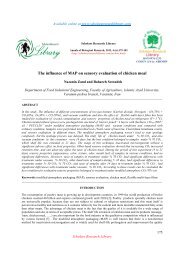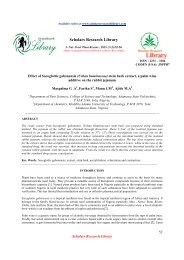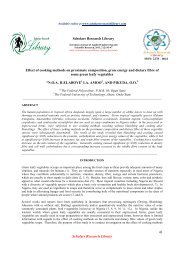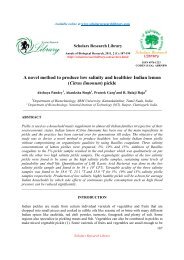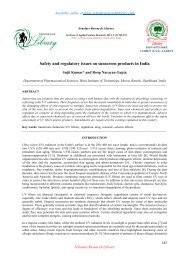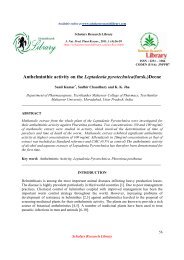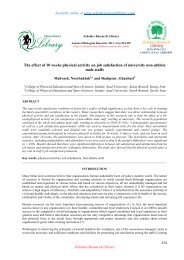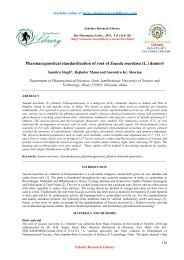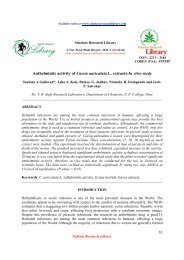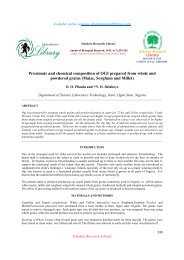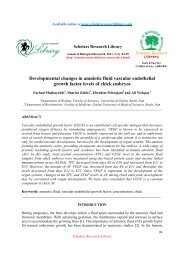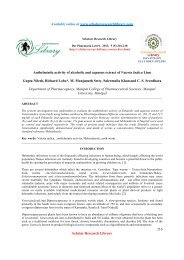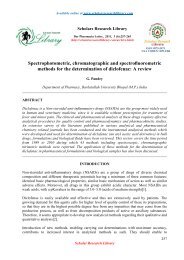Phytochemical analysis, in-vitro screening for antimicrobial and ...
Phytochemical analysis, in-vitro screening for antimicrobial and ...
Phytochemical analysis, in-vitro screening for antimicrobial and ...
Create successful ePaper yourself
Turn your PDF publications into a flip-book with our unique Google optimized e-Paper software.
Available onl<strong>in</strong>e at www.scholarsresearchlibrary.com<br />
Scholars Research Library<br />
Der Pharmacia Lettre, 2013, 5 (1):168-176<br />
(http://scholarsresearchlibrary.com/archive.html)<br />
ISSN 0975-5071<br />
USA CODEN: DPLEB4<br />
<strong>Phytochemical</strong> <strong>analysis</strong>, <strong>in</strong>-<strong>vitro</strong> screen<strong>in</strong>g <strong>for</strong> <strong>antimicrobial</strong> <strong>and</strong> anthelm<strong>in</strong>tic<br />
activity of comb<strong>in</strong>ed hydroalcoholic seed extracts of four selected folklore<br />
<strong>in</strong>dian medic<strong>in</strong>al plants<br />
G. V. Pavan Kumar 1 * <strong>and</strong> S. Naga Subrahmanyam 2<br />
1 Department of Pharmaceutical Chemistry, H<strong>in</strong>du College of Pharmacy, A. P., Guntur, India<br />
2 Department of Pharmaceutics, J N T University, A .P., Vijayanagaram, India<br />
_____________________________________________________________________________________________<br />
ABSTRACT<br />
Antimicrobial properties of medic<strong>in</strong>al plants are be<strong>in</strong>g <strong>in</strong>creas<strong>in</strong>gly reported from different parts of the world.The<br />
ma<strong>in</strong> aim of present research work is to <strong>in</strong>vestigate In<strong>vitro</strong> <strong>antimicrobial</strong> activity, anthelm<strong>in</strong>tic activity <strong>and</strong><br />
Prelim<strong>in</strong>ary screen<strong>in</strong>g <strong>for</strong> phytochemical constituents of the hydroalcoholic extract of Cori<strong>and</strong>rum sativum, Cassia<br />
occidentalis, Carica papaya,Mor<strong>in</strong>ga foetida). Anti- microbial assay was evaluated us<strong>in</strong>g Nutrient agar medium <strong>and</strong><br />
Disc diffusion method at different concentrations (50,100,150,500mg/ml) <strong>and</strong> the results were compared with<br />
therapeutically used antibiotics. Rapid <strong>for</strong>mation of Inhibition zones with<strong>in</strong> 24 hours of <strong>in</strong>cubation was obta<strong>in</strong>ed<br />
with Hydroalcoholic extract 50mg/ml. Anthelm<strong>in</strong>tic activity was evaluated us<strong>in</strong>g adult Indian earthworms,<br />
Pheretima posthuma <strong>and</strong> Tubifex tubifex, hav<strong>in</strong>g anatomical <strong>and</strong> physiological resemblance with <strong>in</strong>test<strong>in</strong>al round<br />
worms parasite. The earthworms were washed <strong>in</strong> normal sal<strong>in</strong>e solution be<strong>for</strong>e they were released <strong>in</strong> to 10ml of<br />
respective <strong>for</strong>mulation as follows, vehicle (2%v/v Tween 80 <strong>in</strong> normal sal<strong>in</strong>e) <strong>and</strong> piperaz<strong>in</strong>e citrate (10mg/ml)<strong>and</strong><br />
prototypes(10,20,50mg/ml). All the Investigations on Hydroalcoholic extract exhibited Antimicrobial <strong>and</strong><br />
Anthelm<strong>in</strong>tic activity at 20mg/ml with significant activity (P
G. V. Pavan Kumar et al Der Pharmacia Lettre, 2013, 5 (1):168-176<br />
_____________________________________________________________________________<br />
medic<strong>in</strong>e <strong>and</strong> folklore claim<strong>in</strong>g that medic<strong>in</strong>al plants as a whole or their parts are be<strong>in</strong>g used <strong>in</strong> all types of diseases<br />
successfully <strong>in</strong>clud<strong>in</strong>g antibacterial <strong>and</strong> anthelm<strong>in</strong>tic, anti-<strong>in</strong>flammatory etc. As we know very well, now a days the<br />
medic<strong>in</strong>al preparation available <strong>in</strong> the market from which most of them either not effective up to the mark or has to<br />
develop resistance result<strong>in</strong>g <strong>in</strong> reoccurrence aga<strong>in</strong>. Plant derived drug serve as a prototype to develop more effective<br />
<strong>and</strong> less toxic medic<strong>in</strong>es.Helm<strong>in</strong>thiasis is among the most important animal diseases <strong>in</strong>flict<strong>in</strong>g heavy production<br />
losses. The disease is highly prevalent particularly <strong>in</strong> third world countries due to poor management of<br />
Helm<strong>in</strong>thiatic practices . A number of medic<strong>in</strong>al plants have been used to treat parasitic <strong>in</strong>fections <strong>in</strong> man <strong>and</strong><br />
animals.The plants are known to provide a rich source of botanical anthelm<strong>in</strong>tics. The anthelm<strong>in</strong>tic assay was<br />
carried as per the method of Ajaiyeoba et al. with m<strong>in</strong>or modifications[1]. The assay was per<strong>for</strong>med on adult Indian<br />
earthworm, Pheretima posthuma <strong>and</strong> Tubifex tubifex due to its anatomical <strong>and</strong> physiological resemblance with the<br />
<strong>in</strong>test<strong>in</strong>al roundworm parasite of human be<strong>in</strong>gs. Because of easy availability, earthworms have been used widely <strong>for</strong><br />
the <strong>in</strong>itial evaluation of anthelm<strong>in</strong>tic compounds <strong>in</strong> <strong>vitro</strong>. Current research aims to highlight <strong>and</strong> prove traditional<br />
anthelm<strong>in</strong>tic medic<strong>in</strong>al properties of plants with a view to focus on future studies.<br />
.<br />
1.1 Occurrence, Botanical description ,Ethnopharmacology <strong>and</strong> Phytochemistry<br />
Cori<strong>and</strong>rum sativum L. (Apiaceae) is an erect annual herb 20–70 cm tall with strong smell. It is widespread<br />
throughout the world as a result of cultivation <strong>for</strong> its aromatic seeds.Extracts from seeds of Cori<strong>and</strong>rum sativum<br />
have several pharmacological effects such as anti-fertility, anti-diabetic, antihyperlipidemic, antioxidant, <strong>and</strong><br />
hypotensive activities [2].Earlier <strong>Phytochemical</strong> screen<strong>in</strong>g <strong>in</strong>dicated the presence of chemicals such as quercet<strong>in</strong> 3-<br />
glucoronide, l<strong>in</strong>alool, camphor, geranyl acetate, geraniol <strong>and</strong> coumar<strong>in</strong>s. The major fatty acids were petrosel<strong>in</strong>ic acid<br />
(65.7% of the total fatty acid methyl esters) followed by l<strong>in</strong>oleic acid, isocoumar<strong>in</strong>s, cori<strong>and</strong>rones C–E, from whole<br />
plants of Cori<strong>and</strong>rum sativum. Two types of 2-C-methyl d- erythriol glycosides were also recently isolated from the<br />
seed of Cori<strong>and</strong>rum sativum.<br />
Cassia occidentalis L. (Caesalp<strong>in</strong>iaceae) is an Ayurvedic plant with important medic<strong>in</strong>al values. It is known by<br />
various names, e.g. Coffee senna, fetid cassia, <strong>and</strong> Negro Coffee (English). In India it is known by its various<br />
vernacular names, the most commonly used ones are Kasamarda, Kaasaari (Ayurveda). Coffee senna grows<br />
throughout the tropics <strong>and</strong> subtropics.In India, C.occidentalis is a common weed found throughout India (up to an<br />
altitude of 1500 m) from Jammu <strong>and</strong> Kashmir to Kanyakumari. C.occidentalis is an erect, somewhat branched,<br />
smooth, semi-woody, fetid herb or shrub, 0.8–1.5 m tall, taproot, hard, stout, with a few lateral roots on mid section.<br />
This plant species varies from a semi-woody annual herb <strong>in</strong> warm temperate areas to a woody annual shrub or<br />
sometimes a short-lived perennial shrub <strong>in</strong> frost free areas .The ma<strong>in</strong> plant chemicals <strong>in</strong> C.occidentalis <strong>in</strong>clude:<br />
achros<strong>in</strong>, aloe-emod<strong>in</strong>, emod<strong>in</strong> , anthraqu<strong>in</strong>ones , anthrones, apigen<strong>in</strong>, aurantiobtus<strong>in</strong>, campesterol, cassioll<strong>in</strong>,<br />
chryso-obtus<strong>in</strong>, chrysophanic acid, chrysarob<strong>in</strong>, chrysophanol , chrysoeriol, emod<strong>in</strong>, essential oils, funiculos<strong>in</strong>,<br />
galactopyranosyl, helm<strong>in</strong>thospor<strong>in</strong>e[3].Other chemical constituents like isl<strong>and</strong>ic<strong>in</strong>e, kaempferol, lignoceric acid,<br />
l<strong>in</strong>oleic acid, l<strong>in</strong>olenic acid, mannitol, mannopyranosyl, matteuc<strong>in</strong>ol, obtusifol<strong>in</strong>, obtus<strong>in</strong>, oleic acid, physcion ,<br />
quercet<strong>in</strong>, rhamnosides, rhe<strong>in</strong>, rubrofusar<strong>in</strong>, sitosterols, tann<strong>in</strong>s, <strong>and</strong> xanthor<strong>in</strong>e have been reported [4].<br />
Carica papaya (Caricaceae) is a tree-like herbaceous plant, a member of the small family Caricaceae <strong>and</strong> widely<br />
cultivated <strong>for</strong> its edible fruits. It orig<strong>in</strong>ates <strong>in</strong> the lowl<strong>and</strong>s of all tropical countries <strong>and</strong> many subtropical regions of<br />
the world. Parts of the plant are used <strong>in</strong> tropical diets as a fruit or vegetable; it is sometime used as a therapeutic<br />
remedy <strong>for</strong> several of its medic<strong>in</strong>al properties. Papaya fruit is thought to conta<strong>in</strong> some immuno-stimulat<strong>in</strong>g <strong>and</strong> antioxidant<br />
agents[5].The immature fruits <strong>and</strong> roots are used <strong>for</strong> their abortifacient activity, the seeds are now be<strong>in</strong>g<br />
used as a potential post-testicular anti-fertility drug ,the pulp is used by African hospitals <strong>for</strong> treat<strong>in</strong>g wounds <strong>and</strong><br />
burns ,the latex <strong>and</strong> the seeds are used <strong>in</strong> the care of gastro<strong>in</strong>test<strong>in</strong>al nematode <strong>in</strong>fections <strong>and</strong> they have shown<br />
anthelm<strong>in</strong>tic activity <strong>and</strong> the seeds <strong>and</strong> immature fruit have shown bacteriostatic activity aga<strong>in</strong>st the human enteric<br />
pathogens .The leaves are used to relieve the symptoms of asthma <strong>and</strong> as a vermifuge, <strong>in</strong> the treatment of gastric<br />
problems, fever <strong>and</strong> amoebic dysentery. Methanolic leaf extract demonstrated vasodilatatory <strong>and</strong> anti-oxidant<br />
effects, both implicated <strong>in</strong> the reduction of cardiovascular risks. The aqueous extract showed beneficial effects <strong>for</strong><br />
the acceleration of wound heal<strong>in</strong>g processes <strong>in</strong> rats .<br />
Momordica foetida (Cucurbitaceae )is a climber commonly found <strong>in</strong> swampy areas. It has medic<strong>in</strong>al uses rang<strong>in</strong>g<br />
from spiritual <strong>and</strong> psychiatric conditions to physical diseases. Dr<strong>in</strong>k<strong>in</strong>g of aqueous leaf extracts of the plant <strong>for</strong><br />
malaria treatment is reported <strong>in</strong> East <strong>and</strong> Central Africa [6].Other medic<strong>in</strong>al uses of extracts of the plant <strong>in</strong>clude the<br />
treatment of hypertension, peptic ulcers, diabetes mellitus, <strong>and</strong> as a purgative. In India, various medic<strong>in</strong>al properties<br />
are claimed <strong>for</strong> Momordica foetida that <strong>in</strong>clude antidiabetic, abortifacient, anthelm<strong>in</strong>tic, contraceptive, antimalarial<br />
Scholar Research Library<br />
169
G. V. Pavan Kumar et al Der Pharmacia Lettre, 2013, 5 (1):168-176<br />
_____________________________________________________________________________<br />
<strong>and</strong> laxative <strong>and</strong> is used <strong>for</strong> treatment of dysmenorrhea, eczema, emmenagogue, galactagogue, gout, jaundice,<br />
kidney (stone), leprosy, leucorrhea, piles, pneumonia, psoriasis, rheumatism <strong>and</strong> scabies It conta<strong>in</strong>s biologically<br />
active chemicals that <strong>in</strong>clude glycosides, sapon<strong>in</strong>s, alkaloids, fixed oils, triterpenes, prote<strong>in</strong>s <strong>and</strong> steroids [7]. The<br />
immature fruits are a good source of Vitam<strong>in</strong> C <strong>and</strong> also provide Vitam<strong>in</strong> A, phosphorus, <strong>and</strong> iron .Several<br />
phytochemicals such as momordenol, momordicil<strong>in</strong>, momordic<strong>in</strong>s, momordic<strong>in</strong><strong>in</strong>, momord<strong>in</strong>, momordolol,<br />
cryptoxanth<strong>in</strong>, cucurbit<strong>in</strong>s, cucurbitac<strong>in</strong>s, cucurbitanes, cycloartenols, diosgen<strong>in</strong>, elaeostearic acids, erythrodiol,<br />
galacturonic acids, gentisic acid, goyaglycosides, goyasapon<strong>in</strong>s, multiflorenol, have been isolated [8].These are<br />
reported <strong>in</strong> all parts of the plant.The hypoglycemic chemicals of plant are a mixture of steroidal sapon<strong>in</strong>s known as<br />
charant<strong>in</strong>s, <strong>in</strong>sul<strong>in</strong>-like peptides <strong>and</strong> alkaloids <strong>and</strong> these chemicals are concentrated <strong>in</strong> fruits , there<strong>for</strong>e fruit has<br />
shown more pronounced hypoglycemic/antihyperglycemic activity. However, two types of hypoglycemic<br />
substances have been differentiated with different time dependent effects—one with fast antihyperglycemic activity<br />
of around 1 h present <strong>in</strong> the aqueous <strong>and</strong> the residue after alkal<strong>in</strong>e chloro<strong>for</strong>m extraction of aqueous extract <strong>and</strong><br />
another with a slow hypoglycemic activity <strong>in</strong> acidic wash of the chloro<strong>for</strong>m extract rema<strong>in</strong><strong>in</strong>g after an alkal<strong>in</strong>e water<br />
wash. HIV <strong>in</strong>hibitory prote<strong>in</strong>s like MRK29 (MW: 28.6 kDa), ssssssMAP30 (MW: 30,000 kDa) <strong>and</strong> lect<strong>in</strong> are<br />
documented [9].The presence of tryps<strong>in</strong> <strong>in</strong>hibitors, elastase <strong>in</strong>hibitors , guanylate cyclase <strong>in</strong>hibitors <strong>and</strong> alphaglucosidase<br />
<strong>in</strong>hibitor like D-(+)-trehalose are also reported [10].<br />
MATERIALS AND METHODS<br />
Plant material<br />
Fresh seeds of plants Cori<strong>and</strong>rum sativum,Cassia occidentalis,Carica papaya,Mor<strong>in</strong>ga foetida were collected from<br />
Asw<strong>in</strong>i Herbal Garden, H<strong>in</strong>du College of pharmacy, Guntur , Andhra Pradesh (A.P), India. Seeds were washed<br />
thoroughly with distilled water <strong>and</strong> then shade dried. All the dried seeds were wholly powdered with the help of<br />
mixer gr<strong>in</strong>der <strong>and</strong> further used <strong>for</strong><br />
extract preparation.<br />
2.1 Prelim<strong>in</strong>ary <strong>Phytochemical</strong> Screen<strong>in</strong>g<br />
The extracts were subjected to prelim<strong>in</strong>ary phytochemical test<strong>in</strong>g to detect <strong>for</strong> the presence of different chemical<br />
groups of compounds. Air-dried <strong>and</strong> powdered Seed materials were screened <strong>for</strong> the presence of tann<strong>in</strong>s, alkaloids,<br />
flavonoids, triterpenoids, steroids, prote<strong>in</strong>s, Am<strong>in</strong>oacids <strong>and</strong> glycosides [11-13].<br />
2.2 Preparation of Plant Extract<br />
Extraction<br />
The extraction of the seeds of four prom<strong>in</strong>ent plants was carried out us<strong>in</strong>g known st<strong>and</strong>ard procedures[14]. The<br />
seeds were dried <strong>in</strong> shade <strong>and</strong> powdered <strong>in</strong> a mixer gr<strong>in</strong>der. The powder (25.0 g) of the seeds were <strong>in</strong>itially defatted<br />
with petroleum ether (60-80°C), followed by 900 ml of hydroalcohol (30:70) by us<strong>in</strong>g a Soxhlet extractor <strong>for</strong> 72<br />
hours at a temperature not exceed<strong>in</strong>g the boil<strong>in</strong>g po<strong>in</strong>t of the solvent. The extracts were filtered us<strong>in</strong>g Whatman filter<br />
paper (No.1) while hot, concentrated <strong>in</strong> vacuum under reduced pressure us<strong>in</strong>g Rotary flask evaporator, <strong>and</strong> dried <strong>in</strong> a<br />
desiccator. The hydroalcoholic extract yields a dark brown solid residue weigh<strong>in</strong>g 5.750 g (23.0% w/w). More<br />
yields of extracts were collected by this method of extractions. The dry weight of the Seeds extract was obta<strong>in</strong>ed by<br />
the solvent evaporation <strong>and</strong> used to determ<strong>in</strong>e concentration <strong>in</strong> mg/ml. The extract was then kept <strong>in</strong> sterile bottles,<br />
preserved at 2- to 4°C under Refregirated conditions until further use . This crude hydroalcoholic extract was then<br />
used to <strong>in</strong>vestigate further <strong>for</strong> potentials of Antimicrobial <strong>and</strong> Anthelm<strong>in</strong>tic properties.<br />
3. Antimicrobial screen<strong>in</strong>g<br />
Test Microorganisms <strong>and</strong> Growth Media<br />
The follow<strong>in</strong>g microorganisms Staphylococcus aureus (MTCC 96), Streptococcus pyogenes (MTCC 442),<br />
Escherichia coli (MTCC 443), Pseudomonas aerug<strong>in</strong>osa (MTCC 424) <strong>and</strong> fungal stra<strong>in</strong>s Aspergillus niger (MTCC<br />
282), Aspergillus clavatus (MTCC 1323), C<strong>and</strong>ida albicans (MTCC 227) were chosen based on their cl<strong>in</strong>ical <strong>and</strong><br />
pharmacological importance[15-19].The bacterial stra<strong>in</strong>s obta<strong>in</strong>ed from Institute of Microbial Technology,<br />
Ch<strong>and</strong>igarh, were used <strong>for</strong> evaluat<strong>in</strong>g <strong>antimicrobial</strong> activity. The bacterial <strong>and</strong> fungal stock cultures were <strong>in</strong>cubated<br />
<strong>for</strong> 24 hours at 37°C on nutrient agar <strong>and</strong> potato dextrose agar (PDA) medium, respectively, follow<strong>in</strong>g refrigeration<br />
storage at 4°C. The bacterial stra<strong>in</strong>s were grown <strong>in</strong> Mueller-H<strong>in</strong>ton agar (MHA) plates at 37°C (the bacteria were<br />
grown <strong>in</strong> the nutrient broth at 37°C <strong>and</strong> ma<strong>in</strong>ta<strong>in</strong>ed on nutrient agar slants at 4°C), whereas the yeasts <strong>and</strong> molds<br />
were grown <strong>in</strong> Sabouraud dextrose agar <strong>and</strong> PDA media, respectively, at 28°C. The stock cultures were ma<strong>in</strong>ta<strong>in</strong>ed<br />
at 4°C.<br />
Scholar Research Library<br />
170
G. V. Pavan Kumar et al Der Pharmacia Lettre, 2013, 5 (1):168-176<br />
_____________________________________________________________________________<br />
3.1 Determ<strong>in</strong>ation of zone of <strong>in</strong>hibition<br />
In <strong>vitro</strong> antibacterial <strong>and</strong> antifungal activities were exam<strong>in</strong>ed <strong>for</strong> comb<strong>in</strong>ed hydroalcoholic extract. Antibacterial<br />
<strong>and</strong> antifungal activities of seed extracts aga<strong>in</strong>st four pathogenic bacteria (two Gram-positive <strong>and</strong> negative) <strong>and</strong><br />
three pathogenic fungi were <strong>in</strong>vestigated by the agar disk diffusion method[20-23].Antimicrobial activity test<strong>in</strong>g<br />
was carried out by us<strong>in</strong>g agar cup method. Comb<strong>in</strong>ed hydroalcoholic extract were dissolved <strong>in</strong> Dimethyl sulfoxide,<br />
sterilized by filtration us<strong>in</strong>g s<strong>in</strong>tered glass filter, <strong>and</strong> stored at 4°C. For the determ<strong>in</strong>ation of zone of <strong>in</strong>hibition, pure<br />
Gram-positive, Gram-negative, <strong>and</strong> fungal stra<strong>in</strong>s were taken <strong>and</strong> antibiotic as a st<strong>and</strong>ard <strong>for</strong> comparison of the<br />
results. The extract were screened <strong>for</strong> their antibacterial <strong>and</strong> antifungal activities aga<strong>in</strong>st the Escherichia coli,<br />
Pseudomonas aerug<strong>in</strong>osa, Staphylococcus aureus, Streptococcus pyogenes <strong>and</strong> the fungi C<strong>and</strong>ida albicans,<br />
Aspergillus niger, <strong>and</strong> Aspergillus clavatus[24-28]. The test compound (CHASE extract of CCCM) of different<br />
concentrations rang<strong>in</strong>g from 50, 100, 150 <strong>and</strong> 200 µg/6 mm disc was <strong>in</strong>troduced <strong>in</strong>to the well <strong>and</strong> the plates were<br />
<strong>in</strong>cubated at 37 0 C <strong>for</strong> 12h. Control experiments were carried out under similar condition by us<strong>in</strong>g ampicill<strong>in</strong>,<br />
chloramphenicol, ciprofloxac<strong>in</strong>, <strong>and</strong> norfloxac<strong>in</strong> <strong>for</strong> antibacterial activity, nystat<strong>in</strong> <strong>and</strong> griseofulv<strong>in</strong> <strong>for</strong> antifungal<br />
activity as st<strong>and</strong>ard drugs [19,20]. The zones of growth <strong>in</strong>hibition around the disks were measured after 18 to 24<br />
hours of <strong>in</strong>cubation at 37°C <strong>for</strong> bacteria <strong>and</strong> 48 to 96 hours <strong>for</strong> fungi at 28°C. The sensitivities of the microorganism<br />
species to the plant extracts were determ<strong>in</strong>ed by measur<strong>in</strong>g the sizes of <strong>in</strong>hibitory zones (<strong>in</strong>clud<strong>in</strong>g the diameter of<br />
disk) on the agar surface around the disks, <strong>and</strong> values
G. V. Pavan Kumar et al Der Pharmacia Lettre, 2013, 5 (1):168-176<br />
_____________________________________________________________________________<br />
5. Statistical Analysis<br />
All results are expressed as mean SEM Groups of data was compared with <strong>analysis</strong> of variance (ANOVA)<br />
.Values would be considered statistically significant, when P
G. V. Pavan Kumar et al Der Pharmacia Lettre, 2013, 5 (1):168-176<br />
_____________________________________________________________________________<br />
bioassay at various concentrations of 10, 20 <strong>and</strong> 50 mg/ml (Table V). The <strong>in</strong>vestigational extract acquired the<br />
anthelm<strong>in</strong>tic activity at m<strong>in</strong>imal dose of 10 mg/ ml. its significant activity (P
G. V. Pavan Kumar et al Der Pharmacia Lettre, 2013, 5 (1):168-176<br />
_____________________________________________________________________________<br />
Figure-1: Anthelm<strong>in</strong>tic activity of Comb<strong>in</strong>ed Hydroalcoholic Seed Extracts of CCCM Plants<br />
DISCUSSION<br />
Antimicrobial properties of medic<strong>in</strong>al plants are be<strong>in</strong>g <strong>in</strong>creas<strong>in</strong>gly reported from different parts of the world. The<br />
World Health Organization estimates that plant extract or their active constituents are used as folk medic<strong>in</strong>e <strong>in</strong><br />
traditional therapies of 80% of the world's population. In the present work, the Hydro alcoholic extracts obta<strong>in</strong>ed<br />
from Cori<strong>and</strong>rum sativum ,Cassia occidentalis,Carica papaya,Momrdica foetida shows strong activity aga<strong>in</strong>st most<br />
of the tested bacterial <strong>and</strong> fungal stra<strong>in</strong>s. The results were compared with st<strong>and</strong>ard antibiotic drugs. In this screen<strong>in</strong>g<br />
work, extracts were found to be not <strong>in</strong>active aga<strong>in</strong>st any organism, such as Gram-positive, Gram-negative, <strong>and</strong><br />
fungal stra<strong>in</strong>s were resistant to Hydroalcoholic extract.The assay of biological activity, of comb<strong>in</strong>ed Hydro<br />
alcoholic extracts were used to evaluate anthelm<strong>in</strong>tic activity, has shown dose dependant activity. The Mean<br />
S.E.M. values were calculated <strong>and</strong> reported . The result of anthelm<strong>in</strong>tic activity on earthworm pheretima<br />
posthuma <strong>and</strong> Tubifex tubifex was given <strong>in</strong> Table-V reveals that, the different concentrations used has shown<br />
paralysis <strong>and</strong> death of worms <strong>and</strong> it was compared <strong>in</strong> the same concentration with Piperaz<strong>in</strong>e citrate as reference<br />
drug. Piperaz<strong>in</strong>e cause hyperpolarization of worms muscle by GABA agonistic action open<strong>in</strong>g Clˉ channels that<br />
cause relaxation <strong>and</strong> depresses responsiveness to contractile action of A.Ch. (Acetylchol<strong>in</strong>e). By <strong>in</strong>creas<strong>in</strong>g chloride<br />
ion conductance of worm muscle membrane produced hyperpolarization <strong>and</strong> reduced excitability that led to muscle<br />
relaxation <strong>and</strong> flaccid paralysis .The seed extracts of cori<strong>and</strong>rum sativum, cassia occidentalis,carica papaya,<br />
Momordica foetida not only demonstrated paralysis, but also caused death of worms especially at higher<br />
Scholar Research Library<br />
174
G. V. Pavan Kumar et al Der Pharmacia Lettre, 2013, 5 (1):168-176<br />
_____________________________________________________________________________<br />
concentration of 50 mg/ml, <strong>in</strong> shorter time. Possible mechanism <strong>for</strong> anthelm<strong>in</strong>tic effect of seed extract of plants are<br />
due to presence of secondary metabolites that they can b<strong>in</strong>d to free prote<strong>in</strong>s <strong>in</strong> the gastro<strong>in</strong>test<strong>in</strong>al tract of host<br />
animal or glycoprote<strong>in</strong> on the cuticle of the parasite <strong>and</strong> may cause death. In addition, Tann<strong>in</strong>s or their metabolites<br />
have a direct effect on the viability of the pre- parasitic stages of helm<strong>in</strong>thes <strong>and</strong> other phytochemicals may be<br />
responsible <strong>for</strong> an anthelm<strong>in</strong>tic effect <strong>in</strong>clude essential oils, flavonoids <strong>and</strong> terpenoids .This speculation is supported<br />
by the vary<strong>in</strong>g rates of effectiveness of medic<strong>in</strong>al plants. The above results show that the activity of hydroalcohol<br />
extracts shows significant antibacterial <strong>and</strong> antifungal activities. This study also shows the presence of different<br />
phytochemicals with biological activity that can be of valuable therapeutic <strong>in</strong>dex. The result of phytochemicals <strong>in</strong><br />
the present <strong>in</strong>vestigation showed that the plant conta<strong>in</strong>s more or less same components like triterpenoids, steroids,<br />
glycosides, anthraqu<strong>in</strong>one, flavonoids, prote<strong>in</strong>s, <strong>and</strong> am<strong>in</strong>o acids. Results show that plant rich <strong>in</strong> tann<strong>in</strong> <strong>and</strong> phenolic<br />
compounds have been shown to posses <strong>antimicrobial</strong> activities aga<strong>in</strong>st a number of microorganisms.<br />
CONCLUSION<br />
In the current <strong>in</strong>vestigation, the hydroalcohol extract <strong>in</strong> the ratio of 30:70 has been selected after study of such a<br />
selected plant with water extracts <strong>and</strong> methanol extracts, hydroalcohol extract gave higher yield of chemical<br />
constituents expected <strong>for</strong> this research work. The orig<strong>in</strong>ality of this work is that good results have been found with<br />
hydroalcohol ratio, <strong>and</strong> it will be helpful to carry out other data with MIC <strong>and</strong> other <strong>for</strong>mulation study, because <strong>in</strong><br />
comparison of methanol or water extracts, hydroalcohol is more suitable <strong>for</strong> cl<strong>in</strong>ical study. The hydroalcoholic<br />
extracts of four plant seeds were found to be active on most of the cl<strong>in</strong>ically isolated microorganism <strong>and</strong> fungi, as<br />
compared with st<strong>and</strong>ard drugs. The present study justified the claimed uses of seeds <strong>in</strong> the traditional system of<br />
medic<strong>in</strong>e to treat various <strong>in</strong>fectious disease caused by the microbes. However, further studies are needed to better<br />
evaluate the potential effectiveness of the crude extracts as the <strong>antimicrobial</strong> agents. The present results will <strong>for</strong>m<br />
the basis <strong>for</strong> selection of plant species <strong>for</strong> further <strong>in</strong>vestigation <strong>in</strong> the potential discovery of new natural bioactive<br />
compounds.<br />
Biological parameter can be concluded that the plants Cori<strong>and</strong>rum sativum,Cassia occidentalis,Carica<br />
papaya,Momordica foetida has significant anthelm<strong>in</strong>tic activity. Further studies us<strong>in</strong>g <strong>in</strong>vivo model are required to<br />
f<strong>in</strong>d out <strong>and</strong> to establish effectiveness <strong>and</strong> pharmacological rationale <strong>for</strong> the use of seeds as anthelm<strong>in</strong>tic drug. In the<br />
light of above mentioned pharmacological effects, it may be concluded that comb<strong>in</strong>ed Hydroalcoholic extract has<br />
the maximum anthelm<strong>in</strong>tic activity.<br />
Acknowledgement<br />
We are grateful to our chairman Dr.Mannava Radha Krishna murthy ,H<strong>in</strong>du college of pharmacy Guntur ,A.P, India<br />
<strong>for</strong> provid<strong>in</strong>g Lab facilities <strong>for</strong> this research work.<br />
REFERENCES<br />
[1] Ajaiyeoba EO, Onocha PA, Olarenwaju OT. Pharm Biol 2001; 39:217- 220.<br />
[2] Al-Said, M.S., Al-Khamis, K.I., Islam, M.W., Parmar, N.S.,Tariq, M., Ageel, A.M., 1987. Journal of<br />
Ethnopharmacology 21, 165–173.<br />
[3] Kudav NA, Kulkarni AB. Ind. J .Chem 1974;12:1042–4.<br />
[4] G<strong>in</strong>de BS, Hosangadi BD, Kudav NA, Nyak KV, Kulkarni AB. I. Chem. Soc. 1970:1285–9.<br />
[5] Aruoma, O.I., Colognato, R., Fontana, I., Gartlon, J., Migliore, L., Koike, K., Coecke, S., Lamy, E., Mersch-<br />
Sundermann, V., Laurenza, I., Benzi, L., Yosh<strong>in</strong>o, F., Kobayashi, K., Lee, M.C., 2006. Biofactors 26 (2), 147–159.<br />
[6] Hakizamungu, E., Van Puyvelde, L., Wery, M., 1992. Journal of Ethnopharmacology 36, 143–146.<br />
[7] Raman, A., Lau, C., 1996. Phytomedic<strong>in</strong>e 2, 349–362.<br />
[8] Husa<strong>in</strong>, J., Tickle, I.J., Wood, S.P., 1994. FEBS Letters 342, 154–158.<br />
[9] Putnam, C.D., Ta<strong>in</strong>er, J.A., 2000. Natural <strong>and</strong> Structural Biology 7, 17–18.<br />
[10] Miura, S., Funatsu, G., 1995. Bioscience Biotechnology <strong>and</strong> Biochemistry 59, 469–473.<br />
[11] Kh<strong>and</strong>elwal KR. 2nd ed. Pune: Nirali Prakashan; 2009. Practical Pharmacognosy; pp. 149-156.<br />
[12] Kokate CK. Delhi: New Gyan Offset Pr<strong>in</strong>ters; 2000. Practical Pharmacognosy; pp. 107– 109.<br />
[13] Kumar A, Ilavarasan R, Jayach<strong>and</strong>ran, Decaraman M, Arav<strong>in</strong>dhan P. Pak J Nutr. 2009;8:83–85.<br />
[14] Harborne JB. Chapman <strong>and</strong> Hall. Newyork: 1973. <strong>Phytochemical</strong> methods: A guide to modern techniques of<br />
plant <strong>analysis</strong>; pp. 279–19.<br />
[15] Maidment C, Dyson A, Haysom I. Nutr.Food Sci 2006; 36 (4): 225 - 230.<br />
Scholar Research Library<br />
175
G. V. Pavan Kumar et al Der Pharmacia Lettre, 2013, 5 (1):168-176<br />
_____________________________________________________________________________<br />
[16] Farnsworth, N .R., (1966). J. Pharm Sci. 55(3), 225-276.<br />
[17] Kuhnt et al., 1994 M. Kuhnt, A. Probestle, H. Rimpler, R. Bauer <strong>and</strong> M. He<strong>in</strong>rich, (1994). Planta Medica, 61,<br />
227–232.<br />
[18] Afolayan AJ, JJM Meyer (1997). J. Ethnopharmacol, 57, 177- 181.<br />
[19] Haslam, E., Lilley, T.H., YaCai, Mart<strong>in</strong>, R., Magnolato, D., (1989). Planta Medica, 55, 18.<br />
[20] Klaudija Carovic´-Stanko, S<strong>and</strong>i Orlic, Olivera Politeo, Frane Strikic, Ivan Kolak, Mladen Milos, Zlatko<br />
Satovic. Food Chem 2010; 119, 196 201.<br />
[21] Rajan S, Baburaj DS, Sethuraman M, Parimala S. Ethnobotany. 2001;6:19–24.<br />
[22] Morimoto S, Nonaka G, Chen R. Chem Pharmacol Bull. 1988;36:39–47.<br />
[23] Bauer AW, Kirby WMM, Sherris JC, Turck M. Am J Cl<strong>in</strong> Pathol. 1966;36:493–6.<br />
[24] Alzoreky NS, Nakahara K. Int J Food Microbiol. 2003;80:223–30.<br />
[25] Rios JL Recio MC, Villar A. J Ethnopharmacol. 1988;23:127–49.<br />
[26] Jawetz, E., Melnick, J.L., Adelberg, E.A., Brooks, G.F., Batel, J.S., Ornston, L.N., (1995). Medical<br />
Microbiology, vol. 20th ed. Appleton <strong>and</strong> Lang, New York<br />
[27] Cerrutti, P., & Alzamora, S. M. (1996). International Journal of Food Microbiology, 29, 379–386.<br />
[28] National Committee <strong>for</strong> Cl<strong>in</strong>ical Laboratory St<strong>and</strong>ards (NCCLS), (1993). Per<strong>for</strong>mance st<strong>and</strong>ards <strong>for</strong><br />
<strong>antimicrobial</strong> disk susceptibility tests, NCCLS, Pennsylvania, USA, , M2-A5<br />
[29] Koroch A.R, Juliani R, Zygadlo J.A. 2007. Bioactivity of essential oils <strong>and</strong> their components.<br />
[30] Lahlou M 2004. Phytotherapy Rresearch. 18, 435-448.<br />
[31] Tatsadijeu N L, Jazet Dongmo P M, Nagassoum M B, Etoa F X, Mbofung c M F, 2009. Foodcontrol 20, 161-<br />
166.<br />
[32] Chang C-W, Chang W-L, Chang S-T, Cheng S-S, 2008. Water Research 42. 278-286.<br />
[33] Pillai LS, Nair BR. Indian J Pharm Sci 2011; 73(1):98-100.<br />
[34] Das SS, Dey M, Ghosh AK. Indian J. Pharm .Sci 2011; 73(1):104-7.<br />
[35] KD Chatterjee, Parasitology, Protozoology <strong>and</strong> Helm<strong>in</strong>thology, 6th ed., In Guha Ray Sree Saraswathy Press<br />
Ltd, Calcutta, 1967.<br />
[36] S Athnasiaduo, I Kyriazakis, F Jackson, RL Coop, Vet parasitol, 2001, 99, 205-219.<br />
[37] DP Thompson, TG Geary, The structure <strong>and</strong> function of helm<strong>in</strong>th surfaces, <strong>in</strong>: J.J. Marr [Ed.], Biochemistry<br />
<strong>and</strong> Molecular Biology of Parasites. 1st ed. Academic Press, New York, pp. 1995, 203-232.<br />
[38] RJ Mart<strong>in</strong>, Vet J, 1997, 154, 11-34.<br />
[39] Bundy DA. Trans Royal Soc Trop Med Hyg 1994; 8:259-61<br />
[40] Idika IK, Okonkwo EA, Onah DN, Ezeh IO, Iheagwam CN, Nwosu CO. Parasitol Res. 2012. [ ahead of pr<strong>in</strong>t]<br />
[41] Lukhoba C W, Simmonds MSJ, Paton AJ, Ethnopharmacol 2006; 103: 1-24.<br />
[42] Gbolade AA, Adeyemi AA. Fitoterapia 2008; 79: 223-5.<br />
[43] Ong HC, Nordiana M. Fitoterapia 1999; 70: 502-13.<br />
[43] Das SS, Dey M, Ghosh AK. Indian J Pharm Sci 2011; 73(1):104-7.<br />
[44] Ja<strong>in</strong> ML, Ja<strong>in</strong> SR. Planta Med 1972; 22:66-70.<br />
[45] Pillai LS, Nair BR. Indian J Pharm Sci 2011; 73(1):98-100.<br />
Scholar Research Library<br />
176



